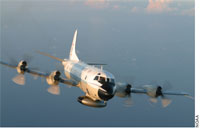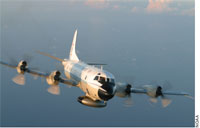
In the Eye of the Storm
This crew regularly flies into hurricanes and sends back crucial data.
- By Marc Barrera
- Jan 02, 2008
 St. Elmo’s Fire, with its eerie emanations
of iridescent hues, possesses a mystical
quality for many. For centuries, sailors
either sought shelter or stood in awe of it.
But for Greg Bast, the phenomenon is just
another part of his job. “It’s aesthetically
pleasing, in that it’s kind of neat to watch it,
but it can also get a little weird when it discharges
and starts running down the side of
the airplane and bouncing off the prop tips
and everything else,” said Bast, who is an
aircraft production controller and WP-3D
flight engineer for the National Oceanic
and Atmospheric Administration’s Aircraft
Operations Center, which is based near
Tampa, Fla., at MacDill Air Force Base.
St. Elmo’s Fire, with its eerie emanations
of iridescent hues, possesses a mystical
quality for many. For centuries, sailors
either sought shelter or stood in awe of it.
But for Greg Bast, the phenomenon is just
another part of his job. “It’s aesthetically
pleasing, in that it’s kind of neat to watch it,
but it can also get a little weird when it discharges
and starts running down the side of
the airplane and bouncing off the prop tips
and everything else,” said Bast, who is an
aircraft production controller and WP-3D
flight engineer for the National Oceanic
and Atmospheric Administration’s Aircraft
Operations Center, which is based near
Tampa, Fla., at MacDill Air Force Base.
What seems to be only a flashy light
display can be a serious matter for Bast
and the rest of the flight
crew, each of whom is
instrumental in the task
of collecting severe
weather data that is then
used for weather forecasting.
The heat generated
from the blast and
the lightning that follows
is often great enough to
leave holes and burn
marks on the hull of
the aircraft, especially
around the rivets holding
the craft together.
“When it bounces off the
rivet heads it leaves spot
welds all over the airplane,
so we have to clean
those up, sand them down, and re-treat
them for corrosion and stuff,” Bast said.
Hostile Territory
For their plane, a Lockheed WP-3D Orion
that has been part of the agency’s fleet since
1975, the toughest challenge comes when
it penetrates a hurricane’s eye wall. While
the eye of a hurricane is relatively calm, the
eye wall can be unpredictably erratic, with
winds rising and falling between 190 and
230 knots. Severe wind speed and the possibility
of being struck by lightning, hail,
and heavy rain are not the only things that
can threaten the safety of the crew; because
the Coriolis force created by the earth’s
rotation causes air currents to curve and go
upward, exiting at the top of the storm, the
eye wall makes the possibility of being hit
by severe vertical wind shears very real.
“Vertical wind shears are the ones that
you’re not often able to pick up,” Bast said.
“Those are the ones that give you the
pretty good ride. We do have a radar that
can detect those; the
problem is that it’s in the
tail and we pretty much
have to go through the
storm before we can see
it.” Depending on the
size of the storm (which
can reach heights of
more than 50,000 feet),
the aircraft is flown at a
height that is determined
to be low enough
to still collect necessary
data and high enough
to minimize the chance
of these occurrences,
which is usually 1,000
to 10,000 feet.
Staying Alert at ‘O’Dark Thirty’
Usually eight to 10 AOC personnel plus six
to nine scientists are on a typical flight.
The crew works through an eight- to ninehour
flight before carrying out a long,
thorough inspection of the plane after
landing. O’Dark Thirty—a play on military
time that is usually used to describe the
hours between midnight and sunrise—presents
the unique danger of fatigue affecting
their decision-making abilities, which can
compromise safety.
Because their jobs demand more than
the average 9-to-5 shift, strict practices are
put into place to minimize the fatigue
factor, especially when Bast and his crewmates
are working at O’Dark Thirty. “That
time of day, with your circadian rhythms,
you’re programmed for sleep. Fatigue sets
in, and that can be a time when you can
really make some mistakes. You’ve got to
be real careful during that period of time,”
he said. “We always double-check ourselves
during that period of time. If somebody
does something, instead of having just
one set of eyes look at it, we’ll normally
have two sets of eyes look at it just to make
sure we’ve done everything properly.”
In addition, Bast added, crews have
mandatory 12-hour rest periods between
flights, eight hours of which must be
used to sleep.
From the outside looking in, it may
seem NOAA’s flight crews are unnecessarily
putting themselves at risk. Bast said
he wants people to understand that the
benefits far outweigh the risks, and safety
is always a number-one priority. “It’s a
funny thing, because a lot of people think,
‘Oh my God, you guys are a bunch of
adrenaline junkies,’ and that’s not true. We
don’t have any cowboys in this business,”
he said. “We don’t have time for that kind
of thinking in our business. We just need
to be as safe as possible, and that’s what we
try to do.”
This article originally appeared in the January 2008 issue of Occupational Health & Safety.